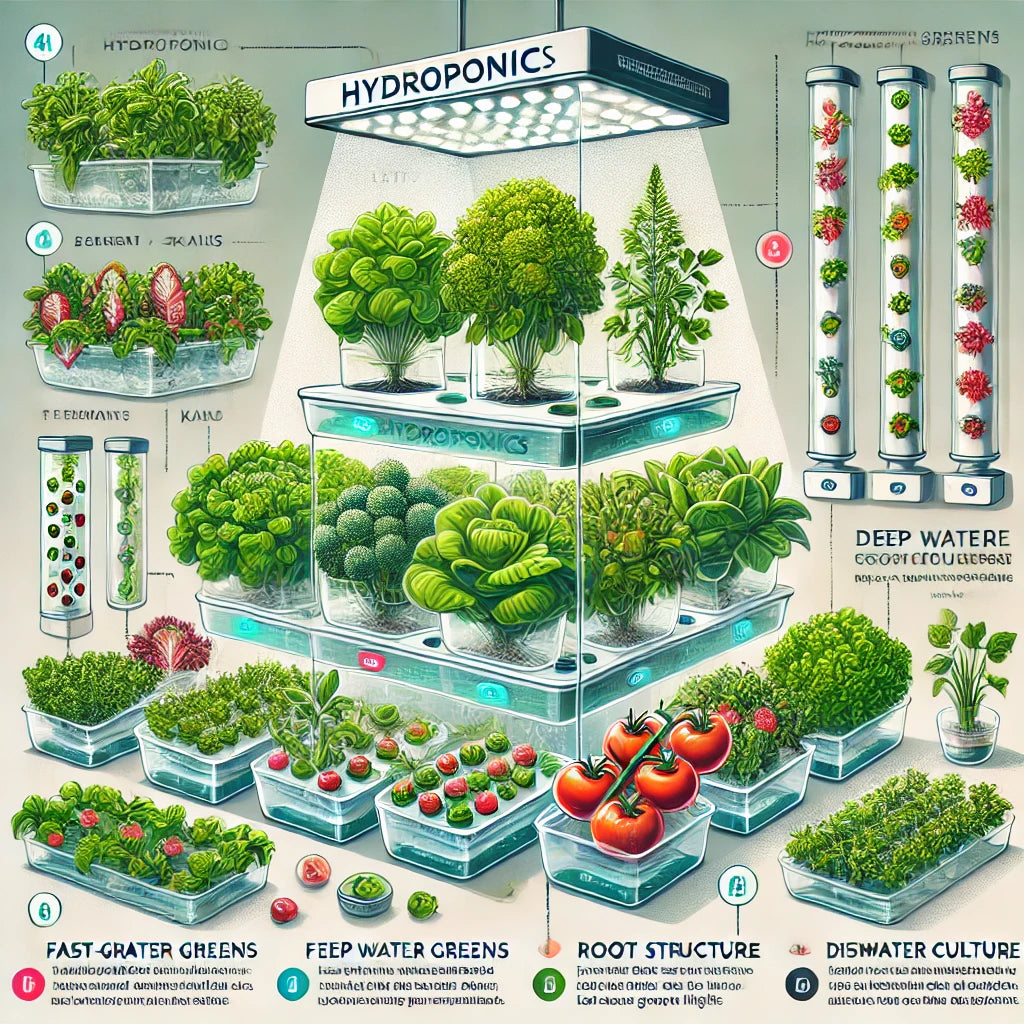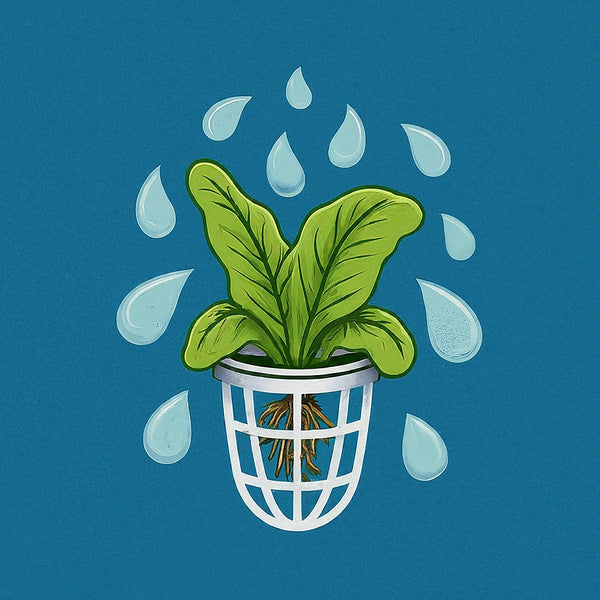
How to Choose the Best Plants for Hydroponics: A Complete Beginner's Guide
Share
Hydroponics is a revolutionary way of growing plants without soil, providing a sustainable and efficient method to cultivate crops. By using nutrient-rich water to nourish plants instead of traditional soil, hydroponic systems are perfect for indoor gardening or areas with poor soil. However, not all plants thrive in hydroponic environments. Selecting the right plants for your system is essential for maximizing growth and yield. In this beginner's guide, we’ll help you make the best choices for your hydroponic garden.
1. Understand the Growth Needs of Your Hydroponic Plants
Every plant has specific requirements for light, temperature, and humidity. When choosing hydroponic plants, it's crucial to ensure they will thrive in the environment you can provide. Here’s what to keep in mind:
- Light Requirements : Since hydroponic systems often require artificial lighting (especially indoors), be sure to select plants that can thrive under grow lights. Plants like leafy greens grow well under standard grow lights, while others may need more intense lighting.
- Temperature and Humidity : Some plants need warmer conditions, while others prefer cooler, more humid environments. Select plants that align with the temperature range and humidity levels of your hydroponic system.
2. Pick Fast-Growing Plants for Hydroponics
Hydroponics is perfect for plants that grow quickly, allowing you to enjoy multiple harvests per year. Fast-growing crops can take full advantage of the constant nutrient and water supply offered by hydroponic systems. Consider these fast-growing options:
- Lettuce: A staple for hydroponic systems, lettuce grows rapidly and can be harvested multiple times a year.
- Spinach: Like lettuce, spinach thrives in hydroponic setups and matures quickly.
- Kale and Arugula: These nutrient-dense leafy greens are excellent choices for hydroponic gardening.
3. Leafy Greens and Herbs Are Ideal for Hydroponic Systems
Leafy greens and herbs are some of the best plants to grow in hydroponic systems, and they are among the most popular choices for beginner hydroponic gardeners. These plants typically have smaller root systems, which makes them well-suited for hydroponics. Additionally, they require less space, allowing you to grow a variety of plants in the same system.
- Basil: This aromatic herb thrives in hydroponic systems, providing fresh leaves for cooking or tea.
- Mint: Mint is easy to grow hydroponically and requires little maintenance.
- Cilantro: This herb grows quickly and can be harvested multiple times, making it an excellent option for hydroponics.

4. Pay Attention to Root Structure
One of the key factors in choosing hydroponic plants is understanding their root structure. Plants with deep, expansive roots may struggle in hydroponic systems because they require more space and nutrients. Therefore, selecting plants with shallow root systems is ideal for maximizing success.
- Shallow-rooted Plants: Lettuce, spinach, and herbs like basil and mint have shallow roots and thrive in water-based systems.
- Root Crops: Root vegetables such as carrots, potatoes, and beets generally require more space for their roots and are less suited to hydroponics.

5. Consider Space and Hydroponic System Type
Hydroponic systems vary in size and design. Some systems are compact, while others are designed to accommodate a larger number of plants. The type of system you use will impact the plants that work best for your setup. For example:
- Vertical Hydroponic Gardens: These systems allow you to maximize space and grow plants like leafy greens and herbs in a compact area.
- Deep Water Culture (DWC): DWC is ideal for plants like lettuce, kale, and herbs, which thrive in nutrient-rich water.
Make sure you choose plants that are suited for the system you have. For example, deep-water systems may work better with smaller, shallow-rooted plants, while vertical farming systems allow you to grow a variety of crops in a limited space.
6. Opt for Disease-Resistant Varieties
While hydroponic gardening reduces the risk of soil-borne diseases, it’s still important to choose plant varieties that are naturally resistant to common diseases. Many seed suppliers offer disease-resistant varieties of popular hydroponic plants that are specifically bred for water-based growth. By selecting these varieties, you'll increase your chances of a successful harvest.
7. Choose Plants Based on Yield and Harvest Cycles
Some hydroponic plants yield crops quickly, while others take longer to mature but produce larger harvests. If you prefer consistent, quick returns, choose plants that grow fast and can be harvested regularly.
- Fast-Yield Plants: Leafy greens like lettuce and herbs like basil grow quickly, so you can enjoy multiple harvests each year.
- Larger Yielding Plants: Fruit-bearing plants like tomatoes, peppers, and strawberries require more time but can provide large yields once matured.
8. Growing Fruiting Plants in Hydroponics: A Rewarding Challenge
Fruiting plants such as tomatoes, peppers, and strawberries can also thrive in hydroponic systems. While these plants require more attention—such as regular pruning and pollination—hydroponic systems can provide them with the right nutrients for successful growth. However, they may need more space to accommodate their larger root systems.
- Tomatoes: Hydroponic tomatoes require more light and space but produce a delicious, high-yield crop.
- Strawberries: Strawberries are also well-suited to hydroponic gardens, especially in vertical setups where space is limited.
9. Experiment with Unique Plants
Once you’ve gained experience with more common hydroponic crops, feel free to experiment with unique varieties. Try growing edible flowers, exotic herbs, or dwarf fruiting plants to diversify your hydroponic garden. These can add both beauty and novelty to your setup.
Conclusion
Choosing the right plants for your hydroponic system is essential to ensure healthy growth and a bountiful harvest. By selecting fast-growing, shallow-rooted plants such as leafy greens and herbs, you can set yourself up for success in hydroponic gardening. Once you feel comfortable, you can experiment with larger plants or fruiting crops like tomatoes and strawberries.
Whether you’re new to hydroponics or looking to expand your knowledge, this method of gardening offers endless possibilities. By making informed plant choices and optimizing your hydroponic system, you can enjoy fresh, homegrown produce all year round.
